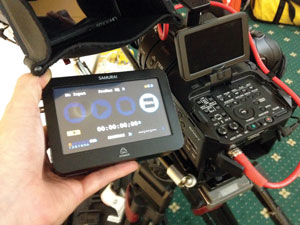Field Report: Atomos’ Samurai
Sometimes the most complex problems require simple solutions. That was the practical thinking of John Ross, chief engineer at Los Angeles-based production company Associated Television International (ATI), when he needed to record multiple simultaneous camera feeds of the new “Marie” show (hosted by Marie Osmond), a live-to-tape production, in the most cost-effective way.
Ross came up with an innovative and highly compact fly pack setup that is easy to move around the set. It features two Atomos Samurai solid-state SDI/HD recorders for each of the six Sony HDC-1500 studio cameras, and two additional recorders capture the program feed.
The Samurai is a portable 10-bit HD recorder, monitor, playback and playout device. It captures video direct from the camera via HD/SD-SDI and encodes in real-time to either Apple ProRes or Avid DNxHD (requires AtomOS 4.0 software) onto low-cost, removable 2½-inch hard disks or solid-state drives.
“When I put together my fly pack, the most expensive part was the ISO recording devices,” Ross said. “Other recorders can run you $25,000 a piece. It didn’t seem to be the most cost-effective use of our funds. All I’m trying to do is record the ISO feeds.”
A highly portable control room
The kit, which serves as a virtual control room, also includes a Miranda Technologies audio embedder and time code generator, all fed into a Panasonic AV-HS450 16-input production switcher with built-in multiviewer software. This allows Ross to shade the cameras and start each recorder in sync with each other at the beginning of each production. Each Samurai is loaded with a 320MB drive, which offers enough capacity to tape two full one-hour shows in 1080p HD, including all of the b-roll they need.
During its rigorous taping season, ATI tapes two one-hour episodes of the show in Los Angeles, each day for three days. Thus far, it has produced 41 shows. (The show started airing last fall, five days a week, on the Hallmark Channel at 9 a.m. ET.)

The Samurai natively records ProRes 422 .MOV and other compressed files, so import and file recognition is fast and easy. There is no transcoding or copying of files.
After each taping, the shows are stored on larger external drives. The recordings are edited in a Final Cut Pro editing suite. (The Samurai natively records ProRes 422 .MOV and other compressed files, so import and file recognition is fast and easy. There is no transcoding or copying of files.) Audio mixing and sweetening is done on a Digidesign Pro Tools HD system with Control 24 software. Because the Samurai can record to the .MOV format, the production crew could actually edit directly from the removable drive if a faster turnaround is required.
Two recorders are better than one
For each camera or live video source, the flyaway kit includes a second recorder to ensure against failure. Ross said when you’re taping a live show, anything can happen, and he can’t afford to miss it. The show uses six Sony HDC-1500 cameras (in studio and handheld configurations). Each camera has a dedicated and backup recorder. Two additional recorders capture the program line feed. The result is 14 recorders, all mounted in only 3RU of space.
The show’s workflow is fast and efficient. HD-SDI signals coming directly from the camera are fed into a Miranda audio embedder. This combined signal is then output from the Samurai and into an Apple Final Cut Pro edit suite for editing.
Program audio is sent to all of the recorders to synchronize the audio tracks from the various on-set and on-camera microphones. This allows the editors to identify and compare the same audio timing on every feed. In addition, it makes it really easy to synch things up when finishing a program.
Ensuring against failure
ATI looked at both hard drive recorders and other types of record/play decks before settling on the Samurai. The LCD monitor screens and the removable storage drives are two reasons they were selected. Other key features include touchscreen operation for record trigger via start/stop flag or timecode and focus/exposure monitoring assist.
The recorder’s latest software includes a feature that protects against losing footage if the camera’s battery runs out or the camera is shut off for any reason. The recorder stops recording a file when power is lost and then resumes in the exact spot where the taping ended. This ensures the crew never misses anything happening on set.
The ATI crew continues to find new uses for the recorders. For instance, the recorders can be mounted on the back of a handheld Sony XDCAM camera and used for on-set interviews.
“We’re always looking for new and efficient ways to produce shows in the most cost effective way,” Ross said. “I think the Atomos recorder offers a lot of possibilities for the money. It’s simple to set up and easy to use and is exactly what we were looking for. I don’t often say that about technology.”
—Michael Grotticelli covers the professional video and broadcast technology industry.
Get the TV Tech Newsletter
The professional video industry's #1 source for news, trends and product and tech information. Sign up below.
